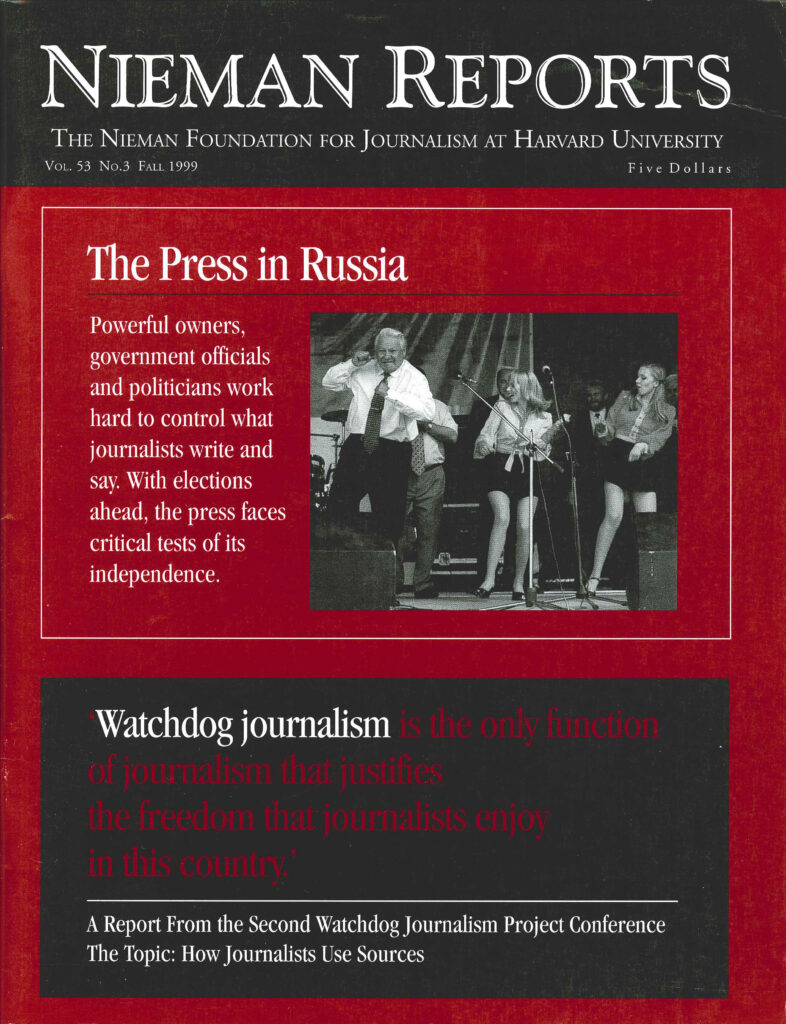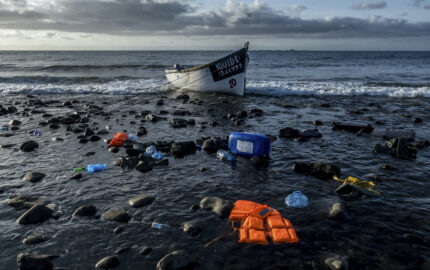Several reporters devoted much of their presentations to describing how they went about finding sources and gathering information from them. In all cases, these reporters did not use anonymous sources and worked hard to ensure that information would be attached to named sources, whenever appropriate. What follows are stages of reporting that show the ways in which sources were approached, interviewed and used in putting the story together.
Loretta Tofani’s inquiry into the topic of jailhouse rapes began after she heard an attorney during a sentencing hearing for a young man about to be sentenced for breaking and entering tell a judge, “Your honor, my client was gang-raped in the county jail.” She asked this judge how often he heard such things. “Oh, it happens all the time,” the judge replied.
She began her reporting by asking other judges the same question. They gave her the same answer. But she remained cautious since the judges couldn’t remember names of men who had been raped. She did not tell her editor about her queries to these judges. “I really needed to develop this a while before I broached the subject in the newsroom and started asking for time to do this project when I was supposed to be turning out daily stories.”
She checked police records: No charges had been brought for rape in the county jail during the previous four years. The sexual assault center said the same thing. Jail spokesman also said there had been no rapes.
Through a source in the sheriff’s office, she was able to get jail guard names and started to contact them at night by going to their homes after putting in her regular hours at the Post. (This source also provided her with their home addresses.) She targeted specific guards who had been involved some years before in a lawsuit against the jail for poor jail conditions. The guards were able to explain to her why the rapes were occurring: They cited understaffing problems, poor jail design, lack of enforcement of rules. These guards told her that rapes and sexual assaults were happening at a rate of about a dozen times a week. They also remembered the victims’ names.
She looked up victims in the courthouse documents and found their home addresses and started to visit them at home. “Getting the victims to talk to me wasn’t so difficult,” Tofani said. “The hard part was using the names. I’d go to their homes, and I went about this a little gingerly. I said I was doing a story about the conditions in the Prince George’s jail. I didn’t say rapes in the first sentence. I was younger then. I looked a little timid and shy myself. Stages of Reporting: Finding and Using Sources They all felt sorry for me and let me in the door. So then we’d talk about the horrible conditions in the jail, the bad food, the horrible toilets, the overcrowding. Then, because the paper had a policy against using victims’ names, I always asked them if I could use their names. Again I appealed to their consciences, and with that appeal, in time I was allowed to use their names.”
After receiving permission from editors to report the story, she initially concentrated on the guards, the victims and medical records. She visited jail medical workers in their homes, after she got their addresses from jail guards. “They did not want to talk to me,” Tofani explained. “I actually visited their homes many times and got doors slammed in my face, so I had to try different ways of reasoning with these people who would slam doors in my face. I’d just go back another night and say, ‘Look, if you know these things are happening, this is a matter of conscience.’ I basically appealed to their consciences as medical people.”
Eventually she got the medical records of men who were raped: “Getting these really was tremendous credibility for this story; it really backed up the victims’ accounts.”
Also, she continued to visit the rape victims at their homes. “I was tremendously moved by the victims’ accounts. I could see their pain and their humiliation, and it was very slow going,” Tofani recalled. “I was a young woman and very sympathetic. And there was really no doubt in my mind that they were telling me the truth.”
She went to the courthouse to look up where the rapists were; they were located in prisons throughout Maryland. “I used different approaches in talking to these men. A lot of it depended on my sense of the person as they walked in the room,” Tofani said. “Dwight Welcher was a young man in the prison in Jessup, Maryland, and when he came in the room his eyes were very stern and direct, so I got right to the point. I told him, as he knew, I was doing a story about the Prince George’s jail and I was very interested in why he had raped Ralph Bunch Gordon in Section 3A on a specific date. At first he refused to talk to me about it. He just laughed and looked at me. Then I said, ‘Look, I’m a reporter. I’m writing a story. I’m not a policeman.’ I just reassured him I wasn’t only writing about this rape. I was writing about the whole jail and how this was the normal phenomenon. I talked and talked, and gradually he became comfortable and ended up talking about his rape of Ralph Bunch Gordon and with great specificity and the kind of detail that let you know that, yes, he really did it. And he was proud of it, too.”
Susan Kelleher teamed up with an experienced reporter, Kim Christensen, to try to document information from sources regarding unethical practices by infertility doctors. The doctors were placing eggs from one infertile woman into another, thereby setting women, unknowingly, on a course to give birth to children who were not biologically their own.
“I first got the tip [about this story] from a senior administrator at the hospital who called me sort of out of the blue to talk about some financial shenanigans that were going on there…. It was a pain in the neck to report. A lot of things she was saying weren’t really checking out paperwork-wise. But I did notice that the University of California, Irvine had a really hostile response to my initial inquiries, which was pretty interesting since the health beat is usually a fairly noncontroversial beat and they had been very cooperative. So my alarm bells sort of went off…. Then at the end of one meeting with this source, this woman says to me, ‘Would you be interested if there was a case where the woman got the wrong eggs? They were taken.’ I was like, ‘absolutely.’”
Kelleher began talking with people from the clinic “at sort of strange times and in strange places.” She explained to potential sources how she worked. “I can’t go with the story just with what people tell me,” she told them. “I’m going to need records.” [See section on “Verifying What Sources Say” for more on Kelleher’s reporting.] She taped all of her interviews and gave a copy of the tape to the person whom she had talked with to allay their fears of being misquoted: “You’ll have a record of what you say and I’ll have a record of what you say,” she would say. “And if there are questions, I can call you.” Also, bringing the copy of the tape to sources she had interviewed—and with whom she wanted to stay in touch—gave her an excuse to go back to their homes.
Tracking down clinic workers was difficult, as was persuading them to talk. “It was really slow trying to find people. It took about five weeks, trying to find people and going back and getting rejected again and again and again. I hate being rejected. It bugs me. And I hate bothering people at their house, but I would go there and say, ‘Oh, sorry,’ and I think after a while they just saw me as this really pathetic person who was just not going to be going away.”
In time, their reporting reached a point “where we had pretty much confirmed that this had happened.” But they decided to keep working on the story “until we found all the patients this had happened to.” But the University was aware of their work on this story and filed a lawsuit [against the doctors] that, in Kelleher’s mind, “made it look like they were doing their job in just trying to ferret out this information and that the doctors were just so uncooperative.”
Once a lawsuit was filed, and due to competition with the Los Angeles Times, the reporters decided to “move ahead with what we’ve got.” They wrote the story the next day and figured “we would go and contact the patients.” Instead, the reporters assigned to this story were called into their editor’s office and told that they were going to contact an ethicist to talk about whether the story should be published.
The ethicist helped the reporters to set up ground rules for how to approach those people who didn’t yet know what these doctors had done with their and others’ eggs. The rules were as follows:
- “We’re going to always go with two people.”
- “We’re going to make sure there’s somebody else at home with the patient.”
- “We’re going to find out as much about the patient [as we can] to see if they have a health condition that might freak them out because basically what we’re telling them is, ‘Hi, you have a child.’ We had records that showed some of these illegal transfers or these egg thefts had resulted in children for other women. And it would be upsetting to people to see that reporters had their medical records.”
With the first patient they went to interview—a woman named Barbara Moore—Kelleher explained that “there would be no article unless she told us whether she had consented or not to this transfer…we basically outlined everything, and they [the couple] just freaked out. We knew that they didn’t consent, but we couldn’t write a story at that point. And we met with them about two days later, and they told us that, in fact, they did not consent to the donation. So we had a big story in that and they had written a letter to the child basically saying, ‘We love you even though we’ve never met you.’ It was incredibly heartbreaking.
“Our next step was to go to the recipient’s house, the people who were raising the child. And to this day, this remains the spookiest thing I’ve ever done because the people were very nice people. They lived maybe about 10 miles away and, as I’m interviewing the father, there is this three-year-old boy playing in the background who looked exactly like the woman I had just interviewed the day before.
“They didn’t believe it and they banished me from the house; they said these people were out to get money from the doctors. I was very respectful of that and left.
“What happened is it wasn’t a story about the egg theft at all; this really was a story about a family, and until we had somebody on the record, with a face, that story was not going to take off. So the families really became the hardest sources to deal with because after a while you get fatigued. You would call people up and listen to their emotional reactions to things—time and time again you would talk to 20, 25, 30 people and tell them this happened, explain the records, and then hear their stories about family and what this meant to them. These weren’t some little eggs in a dish. These were their hopes and dreams for the future.”
David Barstow: “What we attempted to do is to penetrate this story through the use of sources, but to do so in a way that wouldn’t make us beholden to those sources or susceptible to their kind of spin. What we did, essentially, was an all-out assault on every single person that we could possibly find that was connected to this entity. It involved a hell of a lot of knocking on doors and calling people cold and just getting on the ground. Finding the ex-secretaries [of the National Baptist Convention]. Finding the ex-deacons. Finding the guy who ran for president of the organization and lost a couple of years ago. Understanding the politics of this organization. Exploiting the political differences within the organization.”
Byron Acohido: “We have these hard drives where you can stack six years’ worth of work, or more. Divide up your files and log all the stories that everybody published chronologically, or whatever system works for you, so that you get this feel of what is out there. If you are not aware of something, then it’s like quicksand. The corporate forces and different agendas take over again. It’s amazing how the press will repeat spin…. If reporters would just track what’s being written, go into other Web sites where they can get information that helps them piece together what the truth is more likely to be, then we would better serve readers and preserve our credibility.”



